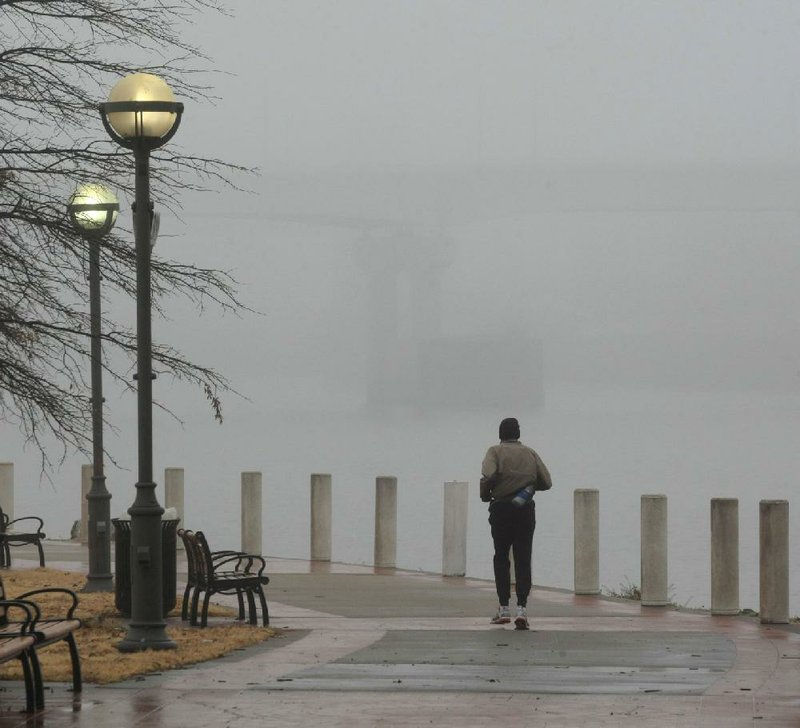LITTLE ROCK — Many runners and walkers who hit the streets before sunrise on chilly winter days know better than to step on any surface that looks even remotely wet. I’m one of them - so intent on studying the road for potential icy spots that I probably wouldn’t notice if the sturdy bungalows that line my neighborhood had been teleported into another dimension overnight.
This eyes-on-the-ground strategy was working just fine at keeping me vertical during predawn runs. Then there was a recent morning when I was following a route near the Arkansas River and started sliding on pavement that didn’t appear to be wet.
After it happened a few times, I would backtrack and paw the area where I thought I had hit a slick spot, but wouldn’t be able to find it.
I was beginning to think there was something wrong with my shoes. Or maybe I had some monstrously bizarre balance/coordination/brain malfunction, as yet undiscovered by Oliver Sacks, that was causing me to think I was skidding when maybe I really wasn’t.
A more practical answer revealed itself around 5 the next morning when I checked the temperature on the Weather Underground website (wunderground.com) before heading out the door into a damp, 30-degree world. There was a little alert symbol on the site. Clicking on it revealed a warning: Beware of freezing fog.
Well, duh.
According to the website Wise Geek (wisegeek.com), when water droplets in fog are below the freezing point but have nothing to crystallize around, they remain in a liquid state. As soon as they come into contact with buildings, trees, roads and sidewalks, they freeze. On concrete they form a thin slick that can cause your feet to scoot out from under you.
Freezing fog, which usually occurs in the morning or evening in late fall and winter, is common around low-lying areas near lakes and rivers.That explains why I don’t encounter it when running or walking through my neighborhood, which is on a ridge crest, but start skidding when I head downhill toward the roads alongside the Arkansas River.
It’s also likely to be found on bridges and overpasses, which are usually the first to freeze because they are surrounded by cold air. Those who are approaching a bridge in a vehicle that has a temperature display can get a pretty good idea of what surface conditions they might encounter if it’s 32 degrees or below and foggy.
If freezing fog turns into freezing rain - raindrops that become supercooled while passing through a sub-freezing layer of air hundreds of feet above the earth’s surface and freeze upon impact with any object they encounter - there will likely be thicker layers of ice on roads, trees, walkways, power lines and other surfaces.Freezing rain, as many Arkansans know all too well, is dangerous and troublesome, but at least you can see it.
As long as we’re defining weather terms, we might as well move on to sleet, often included (along with rain, freezing rain, freezing fog and snow) as part of meteorologists’ trendy informal term “wintry mix.”
According to the University of Illinois online guide to meteorology, sleet is made up of frozen ice pellets that bounce on impact with the ground or other objects. It’s similar to freezing rain in that it causes surfaces to become very slick. It is also different from freezing rain in that it is not clear as glass, can be easily seen, and is less prevalent.
Snow is water vapor frozen into ice crystals that fall in light white flakes. It’s the stuff so many people wanted for Christmas. Unfortunately it brought its wintry mix pals along for a visit. And now we can add freezing fog to the list of unwanted guests.
The best way to avoid fighting with freezing fog? Delay your run or walk until the sun is up and all traces of fog have burned off. Or follow a route with a high elevation. If that’s not possible, watch where you’re going, and take comfort in knowing that even though you can’t see what’s making you slip, it’s really there. Really.
ActiveStyle, Pages 25 on 02/04/2013
